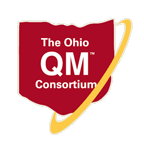About The Ohio QM Consortium
Ohio is Quality Matters’ largest statewide subscriber. 65 higher education institutions have joined the Ohio QM Consortium to date. The Ohio QM Consortium’s stated mission is to provide Quality Matters (QM) support to member institutions through dialogue, professional development, active engagement and assistance in building a culture of quality and continuous improvement in online and blended course offerings.
Ohio QM Consortium Membership benefits include:
Access to the automated, web-based Rubric tool
QM services and materials and subscriber-discounted prices
Free face-to-face Higher Education APPQMR workshops offered by any Ohio QM institution
$25 Fee (significantly discounted) for APPQMR Online sessions offered by QM-Certified Facilitators in Ohio
Free QM Coordinator training
One representative in the online users group (upon request)
Source: http://qmohio.org/about/

It’s 7:59 am on a Friday morning near the end of the spring term and 30 faculty members from local Ohio institutions of higher education are waiting in an open classroom to take the Applying the Quality Matters Rubric (APPQMR) workshop. When some people learn they’re attending a professional development workshop that will last all-day, their eyes glaze over. They picture someone in front of the classroom talking at them for over six hours with a few breaks. However, the workshop participants at Cuyahoga Community College are engaged, learning about the QM Rubric in a way that encourages and welcomes everyone’s involvement. They’re leaving with the skills needed to understand how to apply the QM Standards when designing or updating a course. How did THAT happen? Well…
- The workshop is co-facilitated with two QM-Certified facilitators - an instructional designer and a member of the faculty - who work well together.
- Like all APPQMRs, this workshop incorporates participant viewing of an actual higher education course, which brings real-world experiences to bear on the Standards’ application.
- The workshop has the institution’s QM Coordinator (QMC) there to bring another level of legitimacy and support. Having the QMC stay for the whole workshop is also good for fielding institution-specific questions.
Who are these team facilitators and how did they learn to co-facilitate a workshop?
Mahli Zuan Mechenbibier is a faculty member at Kent State University, Geauga while Evangeline (Litsa) Varonis is primarily an instructional designer (ID) and also a Sr. Lecturer at The University of Akron. Both institutions are members of the Ohio QM Consortium. After completing an online QM professional development course in the same cohort, Litsa and Mahli met two years ago when they carpooled to deliver their first co-facilitated workshop together.
The Ohio QM Consortium connects first-time facilitators with experienced facilitators for additional support. New facilitators shadow experienced facilitators and participate in APPQMR workshops. The Consortium recommends and supports this model, but it is not required.
As part of the Consortium’s facilitator mentor program, both Litsa (far left) and Mahli (left), shadowed Jillian Jevack, who worked at The University of Akron but now is an Instructional Designer at QM. Litsa and Jillian had previously co-facilitated in the spirit of collaboration that guides the Ohio QM Consortium. They divided the presentation based on their strengths. Jillian did the introduction; Litsa led the discussions focused on using the Rubric. During the co-facilitation, each would, when necessary, offer additional support and monitor group work. This type of mentor program is now in place for all new Ohio QM Consortium facilitators. The Ohio QM Consortium also allows facilitators to connect online to share ideas and meet face-to-face once a year at its annual meeting.
Litsa and Mahli have now co-facilitated several times and received great reviews. They do not script presentations, which helps keep lectures fluid. Some faculty struggle with coaching on course design; however, designing and teaching online courses is a collaborative effort, demonstrated in the efficacy of and overall positive responses from having an instructional designer and faculty member lead the workshop. Both have experience as faculty members and course designers, with Mahli primarily representing the faculty perspective and Litsa the instructional designer’s.
The APPQMR is Quality Matters' flagship workshop on the QM Rubric. It covers how to use the QM Rubric to review online courses. It is intended for a broad audience, including, but not limited to:
- faculty
- instructional designers
- administrators adjunct
- instructors who wish to understand more about the QM Rubric and process of course review
The APPQMR workshop uses a combination of lecture, exercises, and debriefs as part of the learning process. In the lecture portion of the workshop, facilitators give relevant examples from their own experiences with the Rubric. Workshop participants review sample online courses to determine if they meet QM Standards. They’re able to familiarize themselves with the QM Rubric. Facilitators offer assistance to groups or one-on-one.
After each exercise, the group is collectively debriefed about its activity. Facilitators lead a discussion regarding areas of difficulty, areas of enjoyment, and lessons learned. The group then brainstorms insights and observations, which allows for constructive criticism and consistently great learning.
Co-facilitating the workshop is beneficial in several ways. The facilitators can:
- share roles
- allocate responsibilities
- provide access to multiple perspectives
Litsa and Mahli work well together and deliver a first-rate workshop because of their complementary skills and abilities. They respond to participant questions and provide double support during group work.
What Do You Learn in the APPQMR?
The APPQMR provides detailed instruction in and understanding of the QM Rubric and the process of writing effective recommendations and applying the QM Rubric to an online course. Upon completion of the Applying the QM Rubric workshop, participants:
- Identify the underlying principles of QM.
- Identify the critical elements of the QM quality assurance program, including the QM Rubric, materials, processes, and administrative components.
- Apply the Higher Education Fifth Edition, 2014 QM Rubric to review online courses.
- Decide if a course meets selected QM Rubric Standards.
- Apply the concept of alignment.
- Draft helpful recommendations for course improvement by citing Annotations from the QM Rubric and evidence from the course.
